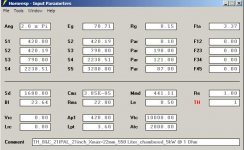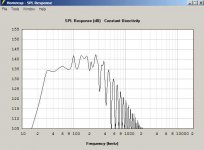B&C SPEAKERS
21IPAL
2500w (AES)
80 mm peak-to-peak
15..22mm linear peak
Flux Density 1.35
FS 37HZ
:O
Interesting...What is up with the 1ohm impedance though? Very odd. April Fools?
"What is up with the 1ohm impedance though?"
Ever try and get 5KW into 8Ω?
A Crest 10001 does 5KW RMS (stereo) into 1Ω, 7.5KW on program material.
Sure...Usually involving bridging an amp... but a 10001 weighs way over 100lbs and most amps aren't really happy with high power into <1ohm minimum loads. That is a lot of current demand. Sure most of the impedance will be over 2 ohms but the minimum will stlll be really low in a few spots and it would make me concerned with most available amplifiers running them hard into that type of load.
Last edited:
You're right, most amplifier won't even run a 2Ω load, much less a 1Ω load. The Crest was designed to run a stereo 1Ω load (137 lbs).
A Crown MA5000vz will do 5KW into 1Ω in mono (77 lbs). The mono MA10,000 is rated at 9.4KW at 1Ω, and can drive as low as 0.5Ω (128 lbs).
McIntosh used to make an amplifier rated to drive a 0.25Ω load in mono, full power, all day long. We used to put them in dance clubs and drive eight 15s. It did weigh 128 lbs though.
The mach speed a vented box would require would seem to rule out a simple vented box, but the driver might have a use in a tapped horn.
http://www.danleysoundlabs.com/pdf/TH%20221%20Spec%20Sheet.PDF
A Crown MA5000vz will do 5KW into 1Ω in mono (77 lbs). The mono MA10,000 is rated at 9.4KW at 1Ω, and can drive as low as 0.5Ω (128 lbs).
McIntosh used to make an amplifier rated to drive a 0.25Ω load in mono, full power, all day long. We used to put them in dance clubs and drive eight 15s. It did weigh 128 lbs though.
The mach speed a vented box would require would seem to rule out a simple vented box, but the driver might have a use in a tapped horn.
http://www.danleysoundlabs.com/pdf/TH%20221%20Spec%20Sheet.PDF
It really is a crazy driver, huge output but very hard to design any kind of box for because of the huge BL/sqrt(Re) (30% higher than the 18sound 21NLW9600 which is the previous champ) and Mms -- a Qes of 0.22 with Fs=37Hz says it all, really.
You'd get almost exactly the same maximum output, efficiency and Vd with a couple of good 18" drivers like the BMS 18N850V2, which might even cost less and would certainly be easier to drive and design suitable boxes for.
I think this driver is a case of seeing what happens if you push driver design to the extreme rather than than something with real advantages over existing solutions -- unless you want to drive massive currents into a 1 ohm load from a class-D amplifier (which can use efficient low-voltage output transistors), like the custom Powersoft module...
You'd get almost exactly the same maximum output, efficiency and Vd with a couple of good 18" drivers like the BMS 18N850V2, which might even cost less and would certainly be easier to drive and design suitable boxes for.
I think this driver is a case of seeing what happens if you push driver design to the extreme rather than than something with real advantages over existing solutions -- unless you want to drive massive currents into a 1 ohm load from a class-D amplifier (which can use efficient low-voltage output transistors), like the custom Powersoft module...
I see now that this is developed as part of a system for Martin and uses a custom Powersoft module. Im still trying to get a little more detail on how the IPAL system functions. I bet these would work well in a couple of cabs but judging from the cost of the 21sw152 currently the cost would be hideous. Extra power to make use of the extra displacement is not cheap either. Wonder if a k10 would run these ok?
This would make a hell of a car audio SPL competition burp sub.
This would make a hell of a car audio SPL competition burp sub.
two tapped horns, side by side, mouths forward:
1.22m high, 1.33m wide
from bottom up to 42cm forms rectangular horn mouth, full width. response of tapped horn about 40 to 140hz
simulating this to 2pi and having real difficulty figuring out exactly how much directional gain in the upper register im going to gain, because of the extra 80cm above the horn mouth and large width.
some attempts with this Online Baffle Step Calculation
questimating 6db level "corresponds" simulation to 1pi in hornresp. some rule of thumb would be useful.
1.22m high, 1.33m wide
from bottom up to 42cm forms rectangular horn mouth, full width. response of tapped horn about 40 to 140hz
simulating this to 2pi and having real difficulty figuring out exactly how much directional gain in the upper register im going to gain, because of the extra 80cm above the horn mouth and large width.
some attempts with this Online Baffle Step Calculation
questimating 6db level "corresponds" simulation to 1pi in hornresp. some rule of thumb would be useful.
You may be able to make a reasonable estimate from the empirical data collected in these threads:simulating this to 2pi and having real difficulty figuring out exactly how much directional gain in the upper register im going to gain, because of the extra 80cm above the horn mouth and large width.
questimating 6db level "corresponds" simulation to 1pi in hornresp. some rule of thumb would be useful.
http://www.diyaudio.com/forums/subwoofers/204472-multiple-cabinet-combined-response.html
http://www.diyaudio.com/forums/subwoofers/184986-horn-extender-wave-guide-th.html
The short answer is from 2-3 (near Fb) to 4 dB upper end forward gain. To find out the exact amount will require measurement.
Art Welter
Last edited:
It really is a crazy driver, huge output but very hard to design any kind of box for because of the huge BL/sqrt(Re) (30% higher than the 18sound 21NLW9600 which is the previous champ) and Mms -- a Qes of 0.22 with Fs=37Hz says it all, really.
You'd get almost exactly the same maximum output, efficiency and Vd with a couple of good 18" drivers like the BMS 18N850V2, which might even cost less and would certainly be easier to drive and design suitable boxes for.
I think this driver is a case of seeing what happens if you push driver design to the extreme rather than than something with real advantages over existing solutions -- unless you want to drive massive currents into a 1 ohm load from a class-D amplifier (which can use efficient low-voltage output transistors), like the custom Powersoft module...
There's a detailed explanation of how the whole IPAL system works here:
http://www.diyaudio.com/forums/subw...dio.com/.../644-powersoft-b-c-ipalmod-system-...
Basically it uses pressure sensor feedback and a DSP to not only provide feedback to reduce distortion and improve transient response, but lets you "dial in" any virtual T-S parameters you want. Net result should be huge output and low distortion from a smaller than normal box. The improvement in transient response shown in the paper is phenomenal...
The huge BL is partly there to raise efficiency when used with the custom class-D Powersoft amp my making the back EMF as high as possible and making the load as reactive as possible -- not normally a good idea, but it is in this case.
Before objecting that this won't work, read the paper, it's a proper AES one not some technically illiterate publicity puff.
It all looks great apart from only being available to OEMs and horribly expensive -- the driver is said to cost double what a 21SW152 does so even if you could buy them the driver + amp would cost several thousand quid a pop :-(
And this is what it's used in -- cost is £10k each...
http://www.martin-audio.com/products/datasheets/ASXdatasheet.pdf
Last edited:
intersting(but expensive)stuff.There's a detailed explanation of how the whole IPAL system works here:
http://www.diyaudio.com/forums/subw...dio.com/.../644-powersoft-b-c-ipalmod-system-...
Basically it uses pressure sensor feedback and a DSP to not only provide feedback to reduce distortion and improve transient response, but lets you "dial in" any virtual T-S parameters you want. Net result should be huge output and low distortion from a smaller than normal box. The improvement in transient response shown in the paper is phenomenal...
The huge BL is partly there to raise efficiency when used with the custom class-D Powersoft amp my making the back EMF as high as possible and making the load as reactive as possible -- not normally a good idea, but it is in this case.
Before objecting that this won't work, read the paper, it's a proper AES one not some technically illiterate publicity puff.
It all looks great apart from only being available to OEMs and horribly expensive -- the driver is said to cost double what a 21SW152 does so even if you could buy them the driver + amp would cost several thousand quid a pop :-(
And this is what it's used in -- cost is £10k each...
http://www.martin-audio.com/products/datasheets/ASXdatasheet.pdf
i like how you could emulate al ts parameters.
btw your link doesnt work
correct link
Hey guys,
Can you help me out, i have an 8" driver that goes down to around 30hz. I want to make a tapped horn for my econowave mains. It seems my econowave can only go down to 50 hz. I would like to augment this with a tapped horn. Can you point me to a good design please? I will post pictures of the finished product when done.
Thanks very much.
Btw, can tapped horns do slam?
Can you help me out, i have an 8" driver that goes down to around 30hz. I want to make a tapped horn for my econowave mains. It seems my econowave can only go down to 50 hz. I would like to augment this with a tapped horn. Can you point me to a good design please? I will post pictures of the finished product when done.
Thanks very much.
Btw, can tapped horns do slam?
- Home
- Loudspeakers
- Subwoofers
- Collaborative Tapped horn project

